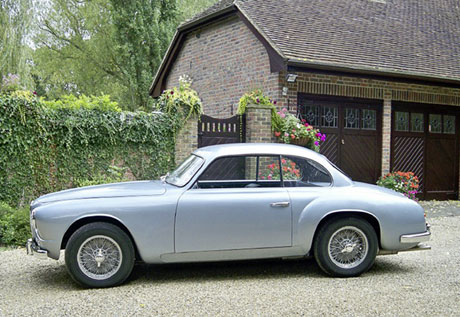SCM Analysis
Detailing
| Vehicle: | 1953 Alfa Romeo 1900C Sprint |
| Number Produced: | 949 (Sprint), 854 (Super Sprint) |
| Original List Price: | $5,184 |
| Tune Up Cost: | $175 |
| Chassis Number Location: | Engine bulkhead, stamped into metal |
| Engine Number Location: | Intake side of block |
| Website: | http://www.ar1900reg.org |
| Alternatives: | 1953 Lancia B20 GT, 1953 Maserati A6G/2000, 1953 Aston Martin DB2/4 |
This 1953 Alfa Romeo 1900C Sprint sold for $90,302, including buyer’s premium, at the Bonhams Goodwood Revival auction in Chichester, Sussex, England, on September 18, 2009.
The importance of the 1900 as the first modern Alfa cannot be overstated. It was the car that began the transformation of the company from a builder of race cars and a handful of ultra-expensive road cars each year to a real manufacturer, bringing a level of sporting driving to an audience of hundreds of thousands and ultimately millions.
Origins of Alfa’s “family face”
The 1900 was “modern” in terms of the late 1940s, with a unit body and genuine 100-mph performance from the TI (Touring International) version. The tradition of special bodies wasn’t lost with the 1900, however, as a platform version of the unit chassis for custom builders was also developed and used for coupe and convertible versions by Carrozzeria Touring, Pinin Farina, and others.
The Alfa Romeo “family face,” which the catalog credits to the Series I and II Touring coupe, actually came from the factory sedan, but there’s little doubt that the original “five-window” 1900 coupe is an elegant design, with many hints of Touring’s previous work on the Alfa 6C 2500 chassis, especially the Villa d’Este coupe.
In fact, it was taken almost unchanged from a proposal for a larger car that was never built-a post-war 6C 3000, which was planned to succeed the 6C 2500SS. It also should be clarified from the catalog description that the Super Sprint of 1954 was not the “Series II” but rather followed that model.
Along with the 1,975-cc engine, twin carburetors, and 5-speed gearbox, the Super Sprint also came with a completely new “three-window” Touring body, which bore a family resemblance to the Mario Boano-designed, Bertone-built Giulietta Sprint.
In order to be as usable as possible in rallies and tours today, the twin-carburetor, 5-speed gearbox Super Sprint spec is almost a requirement. The 1900’s successor, the “cast iron” 2000, featured the same 1,975-cc engine as fitted to the late 1900 cars, but with important developments in internal structure. The key change made it much easier to shim adjustable valves-and as they look almost identical from the outside, it’s fairly common to find 1900s that have been fitted with later engines and 5-speed transmissions, as this one has.
Eligible for practically every event around the world
While the 1900 had a very successful competition record in period and is eligible for practically every event around the world, including the Mille Miglia, values have not reflected this in all models. Not surprisingly, the rare Zagato-bodied cars are the most valuable, and the differential has grown to where they are three times the price of the best of the Touring cars.
The berlinas, which have a very good racing history, can be had for less than half the price of an okay Touring coupe. The 1900’s great competitor in period-on the track and in the showroom-was Lancia’s Aurelia. The Lancia offered a much more sophisticated specification, with V6 engine, transaxle, and inboard brakes, but typically less power than comparable Alfas.
The two approaches are probably best described as a bit edgy and nervous for Alfa Romeo vs. smooth and relaxed for Lancia. To many contemporary drivers, the Alfa’s chassis no longer feels as “modern” as the Lancia’s, and much of the power difference is less meaningful today. In my opinion, the 1900 Sprint isn’t as engaging a drive as the Aurelia B20 and as a result, is not as sought after for vintage events.
That, I think, has contributed to the relative lack of upward movement in 1900 Sprint prices that might have been expected in the past few years. However, in a softer market, their prices have also not slid much. This result seems slightly above average for an average car.
